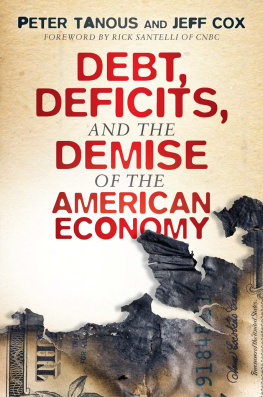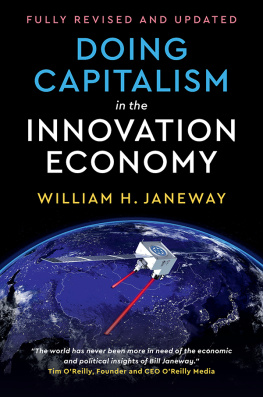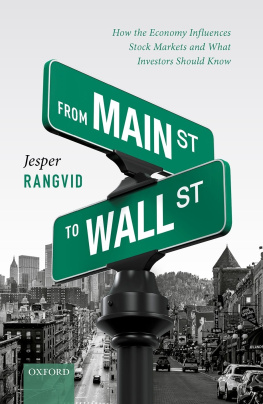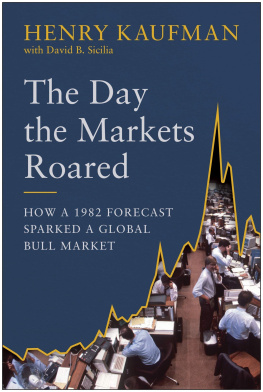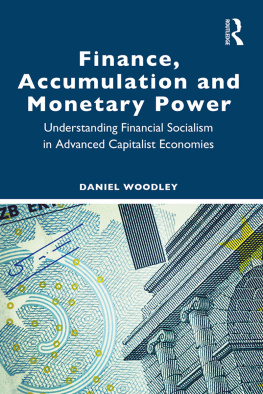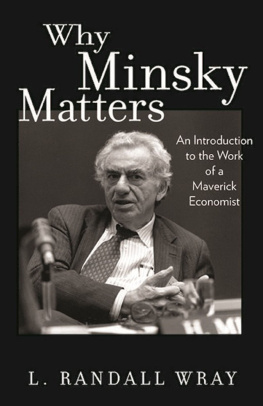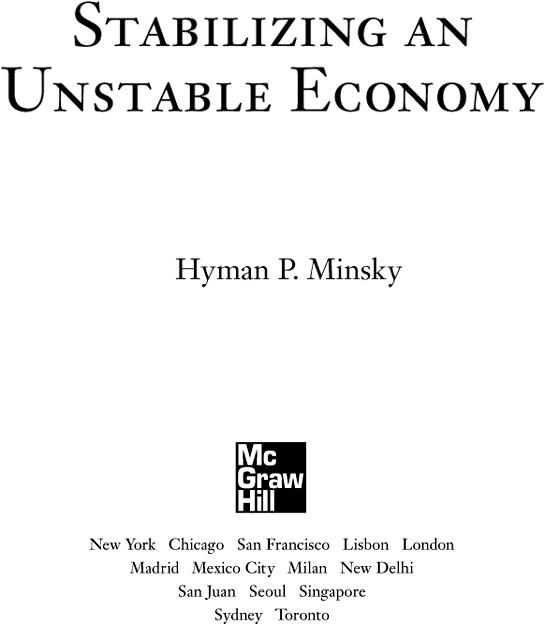

Copyright 2008 by Hyman Minsky. All rights reserved. Except as permitted under the United States Copyright Act of 1976, no part of this publication may be reproduced or distributed in any form or by any means, or stored in a database or retrieval system, without the prior written permission of the publisher.
ISBN: 978-0-07-159300-7
MHID: 0-07-159300-4
The material in this eBook also appears in the print version of this title: ISBN: 978-0-07-159299-4, MHID: 0-07-159299-7.
All trademarks are trademarks of their respective owners. Rather than put a trademark symbol after every occurrence of a trademarked name, we use names in an editorial fashion only, and to the benefit of the trademark owner, with no intention of infringement of the trademark. Where such designations appear in this book, they have been printed with initial caps.
McGraw-Hill eBooks are available at special quantity discounts to use as premiums and sales promotions, or for use in corporate training programs. To contact a representative please e-mail us at bulksales@mcgraw-hill.com.
TERMS OF USE
This is a copyrighted work and The McGraw-Hill Companies, Inc. (McGraw-Hill) and its licensors reserve all rights in and to the work. Use of this work is subject to these terms. Except as permitted under the Copyright Act of 1976 and the right to store and retrieve one copy of the work, you may not decompile, disassemble, reverse engineer, reproduce, modify, create derivative works based upon, transmit, distribute, disseminate, sell, publish or sublicense the work or any part of it without McGraw-Hills prior consent. You may use the work for your own noncommercial and personal use; any other use of the work is strictly prohibited. Your right to use the work may be terminated if you fail to comply with these terms.
THE WORK IS PROVIDED AS IS. McGRAW-HILL AND ITS LICENSORS MAKE NO GUARANTEES OR WARRANTIES AS TO THE ACCURACY, ADEQUACY OR COMPLETENESS OF OR RESULTS TO BE OBTAINED FROM USING THE WORK, INCLUDING ANY INFORMATION THAT CAN BE ACCESSED THROUGH THE WORK VIA HYPERLINK OR OTHERWISE, AND EXPRESSLY DISCLAIM ANY WARRANTY, EXPRESS OR IMPLIED, INCLUDING BUT NOT LIMITED TO IMPLIED WARRANTIES OF MERCHANTABILITY OR FITNESS FOR A PARTICULAR PURPOSE. McGraw-Hill and its licensors do not warrant or guarantee that the functions contained in the work will meet your requirements or that its operation will be uninterrupted or error free. Neither McGraw-Hill nor its licensors shall be liable to you or anyone else for any inaccuracy, error or omission, regardless of cause, in the work or for any damages resulting therefrom. McGraw-Hill has no responsibility for the content of any information accessed through the work. Under no circumstances shall McGraw-Hill and/or its licensors be liable for any indirect, incidental, special, punitive, consequential or similar damages that result from the use of or inability to use the work, even if any of them has been advised of the possibility of such damages. This limitation of liability shall apply to any claim or cause whatsoever whether such claim or cause arises in contract, tort or otherwise.
CONTENTS
2. A DEEP RECESSION BUT NOT A DEPRESSION IN 1975:
THE IMPACT OF BIG GOVERNMENT
3. A DEEP RECESSION BUT NOT A DEPRESSION IN 1975:
THE IMPACT OF LENDER-OF-LAST-RESORT INTERVENTION
FOREWORD
When Hyman Minskys book originally was published more than two decades ago, it was ahead of its time. This is often the case with economic thinkers. Joseph Schumpeter enjoys greater influence today than he did in his own time, and the seminal ideas of John Maynard Keynes gained broad influence well after they were published. So too with the indefatigable Minsky. Although he was a force to be reckoned with during the l970s and 1980s, his ideas never have been more salient than today. If Minsky were alive today, he could justly claim I told you so to those who have paid close attention to economics and finance in the last few decades. There is no better moment to reissue this Minsky classic.
Like Keynes (about whom Minsky published a biography in 1975) and Schumpeter, Minsky was centrally concerned with business cycles. The Keynesianism that became dominant following World War II focused chiefly on the politically popular aspects of Keynes writings. Too few recalled that Keynes recommended monetary action before fiscal activism and budget surpluses during periods of growth. For too many policymakers, Keynesianism meant deficit spending as an all-too-easy and automatic fix. There was a growing sense that Keynesianism had conquered the business cycle, as reflected in terminology like soft landing and mid-course correction.
Hyman Minsky forged a different and important connection with Keynes. He emphasized the volatility of investments, pointing out that the underlying uncertainty of the cash flow from investments has powerful repercussions on the balance sheets of business. It was an important insight that deserved much greater attention.
After monetarism eclipsed Keynesianism in the late 1970s and 1980s, Minskys insights again were not given their due. Even at its zenith in the early 1980s, monetarism failed to cope effectively with the changing structure of the financial system, which Minsky so eloquently dealt with in his broad analytical approach. Meanwhile, econometrics had become almost a religion among economists and financial analysts. But Hyman Minsky did not allow his analysis to be constrained by statistical models. He sagely understood that mathematical equations cannot properly account for significant crucial structural changes or shifts in behavioral patterns in economics and finance.
I was attracted to the work of Hyman Minsky early on in my career in the financial markets. In my own work, I became increasingly concerned by how debt continued to grow more rapidly than nominal gross national product. I attribute this unwholesome development to the rapid securitization of financial assets, the globalization of financial markets, and vast improvements in information technology that facilitated, among other things, the quantification of risk taking. The risks inherent in exploding debt have been heightened by the failure of official policymakers to put into place safeguards that encourage financial institutions to balance their entrepreneurial drive with their fiduciary responsibilities.
Hyman Minskys insights help us understand the key financial developments of recent decades. Few understood as well as Minsky the self-reinforcing dynamic of speculative corporate finance, decreasing debt quality, and economic volatility that has come to characterize our times. He called corporate borrowing for the purpose of repaying debt speculative finance, which in turn drives up investment and asset prices. He explained how the bullish rise in employment, investment, and profits tends to confirm, in the minds of business leaders and bankers, the soundness of an approach that ultimately fosters volatility and unacceptable risk. In a colorful phrase that could be the watchword for the Age of Enron, Minsky cautioned against balance-sheet adventuring.
What followed the original publication of this book, therefore, hardly would have surprised its authorfrom the savings and loan and banking crises in the late 1980s and early 1990s; to the Mexican and Korean debt travails, the Russian debt default, and the near hemorrhaging of the markets caused by the excessive leveraging of Long-Term Capital Management in the 1990s; to the bursting of the high-tech bubble in 2000.
Next page


